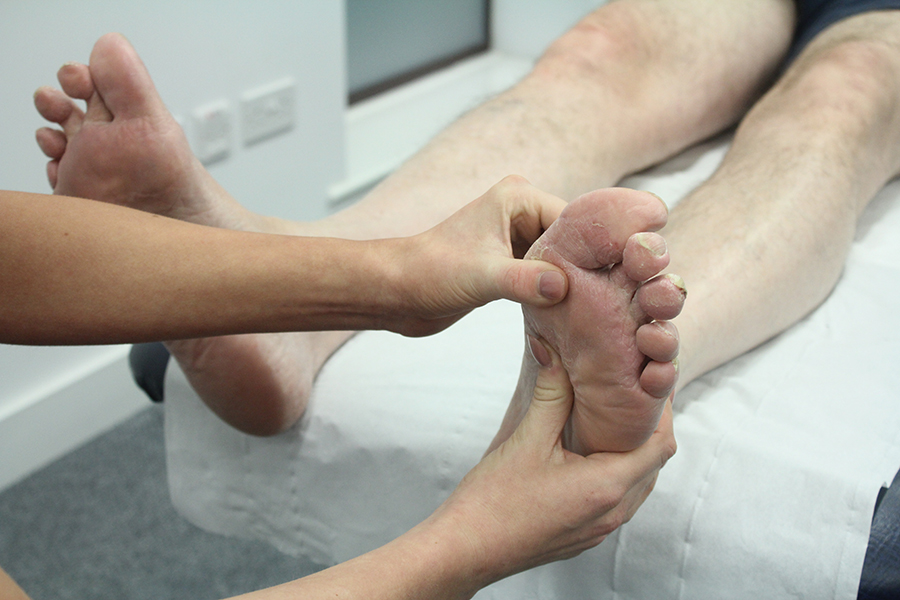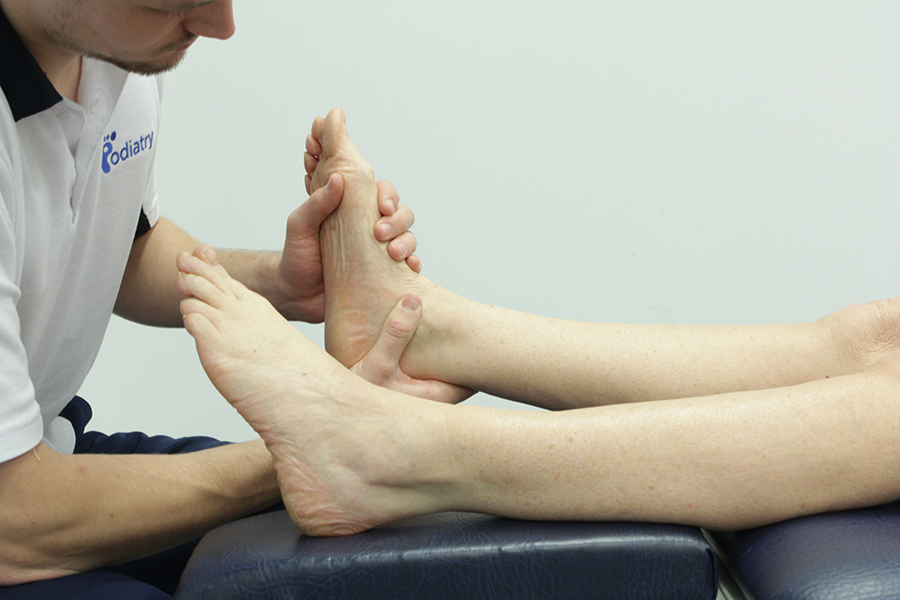Cuboid syndrome
Cuboid syndrome is a painful condition that affects the outside of the foot, caused by the cuboid subluxing (partially dislocating). When the cuboid subluxes it moves out of position and this can cause pain in the foot.
If you think you have cuboid syndrome you should visit a podiatrist who will be able to help you.
Cuboid syndrome is the name given to the partial dislocation (subluxation) of a bone in the foot known as the cuboid. The cuboid, as its name suggests, is cuboid in shape and is positioned on the outside of the foot between the ankle and the fourth and fifth metatarsal.
The cuboid articulates with a number of bones in the foot, however cuboid syndrome refers only to the partial dislocation of the calcaneocuboid joint; this is where the calcaneus (the heel bone) and the cuboid meet.
The cuboid together with the calcaneus, talus, navicular and the three cuneiforms form the tarsus. The tarsus is a very clever structure, as when the leg rotates in one direction it locks together tightly and forms a rigid structure, and when the leg rotates the opposite way it unlocks and becomes mobile; this allows the foot to adapt to different walking surfaces.
Beneath the cuboid is a groove that the tendon of a muscle called peroneus longus runs through. The tendon of peroneus longus is thought to be responsible for cuboid syndrome by pulling the cuboid out of position.

Cuboid syndrome has a number of contributing factors. The most common contributing factor of cuboid syndrome has been cited as over-pronation. Pronation describes a normal movement of the foot, which occurs in order to absorb shock and adapt to different terrain. Over-pronation is when the foot remains in a pronated position during gait.
Pronation increases the likelihood of cuboid syndrome, this is because when the tarsal bones unlock and the foot becomes mobile (which occurs during pronation) the peroneus longus muscle automatically lifts the outside of the foot. This movement de-stabilises the foot making a subluxation of the cuboid more likely. Additionally, a very mobile foot increases the mechanical advantage of peroneus longus. This means that the tendon is exerting a lot of force, which can move the cuboid out of place.
When the cuboid is out of position (subluxed) the tendon of peroneus longus becomes irritated and this is what causes pain.
Other contributing factors for cuboid syndrome include:
The signs and symptoms of cuboid syndrome include:
Cuboid syndrome can be diagnosed by a podiatrist. A podiatrist is a university trained medical professional who is able to diagnose and treat a variety of conditions associated with the foot and lower limb.
If you have cuboid syndrome you can expect the following benefits upon assessment and management at Chiropody.co.uk:

Your podiatrist would first obtain a thorough medical and social history, which along with an examination of the area and the signs and symptoms will lead the podiatrist to a diagnosis. If you have cuboid syndrome your podiatrist will discuss a treatment plan with you. It may be that you require a Biomechanical assessment, if this is the case you will be referred for one of these and orthoses will be prescribed.
Treatment for cuboid syndrome is aimed at reducing pain and inflammation, and re-positioning the cuboid, this may include:
Cuboid syndrome is a painful condition that affects the outside of the foot. The pain occurs due to the partial dislocation of the cuboid, which is a small bone in the foot that forms part of the tarsus.
The main contributing factor to cuboid syndrome is over-pronation, however other factors known to contribute to its occurrence include; lateral ankle sprain, poor footwear construction and uneven terrain.
There are a number of treatment options for cuboid syndrome. Visit one of our podiatrists who will be able to advise on the one that is best for you.
To arrange an assessment with one our podiatrists please email office@chiropody.co.uk or call 0330 088 4222.
If you think you have cuboid syndrome you should visit a podiatrist who will be able to help you.
What is cuboid syndrome?
Cuboid syndrome is the name given to the partial dislocation (subluxation) of a bone in the foot known as the cuboid. The cuboid, as its name suggests, is cuboid in shape and is positioned on the outside of the foot between the ankle and the fourth and fifth metatarsal.
The cuboid articulates with a number of bones in the foot, however cuboid syndrome refers only to the partial dislocation of the calcaneocuboid joint; this is where the calcaneus (the heel bone) and the cuboid meet.
The cuboid together with the calcaneus, talus, navicular and the three cuneiforms form the tarsus. The tarsus is a very clever structure, as when the leg rotates in one direction it locks together tightly and forms a rigid structure, and when the leg rotates the opposite way it unlocks and becomes mobile; this allows the foot to adapt to different walking surfaces.
Beneath the cuboid is a groove that the tendon of a muscle called peroneus longus runs through. The tendon of peroneus longus is thought to be responsible for cuboid syndrome by pulling the cuboid out of position.

What causes cuboid syndrome?
Cuboid syndrome has a number of contributing factors. The most common contributing factor of cuboid syndrome has been cited as over-pronation. Pronation describes a normal movement of the foot, which occurs in order to absorb shock and adapt to different terrain. Over-pronation is when the foot remains in a pronated position during gait.
Pronation increases the likelihood of cuboid syndrome, this is because when the tarsal bones unlock and the foot becomes mobile (which occurs during pronation) the peroneus longus muscle automatically lifts the outside of the foot. This movement de-stabilises the foot making a subluxation of the cuboid more likely. Additionally, a very mobile foot increases the mechanical advantage of peroneus longus. This means that the tendon is exerting a lot of force, which can move the cuboid out of place.
When the cuboid is out of position (subluxed) the tendon of peroneus longus becomes irritated and this is what causes pain.
Other contributing factors for cuboid syndrome include:
- Lateral ankle sprain
- Poor footwear construction
- Uneven terrain
What are the signs and symptoms of cuboid syndrome?
The signs and symptoms of cuboid syndrome include:
- A deep dull pain or ache on the outside of the foot or the mid foot
- Pain that radiates to the underside of the foot near the arch
- Tenderness along the course of the peroneus longus tendon
- Pain is worse when standing or upon activity
How is cuboid syndrome diagnosed?
Cuboid syndrome can be diagnosed by a podiatrist. A podiatrist is a university trained medical professional who is able to diagnose and treat a variety of conditions associated with the foot and lower limb.
Benefits of podiatry for cuboid syndrome
If you have cuboid syndrome you can expect the following benefits upon assessment and management at Chiropody.co.uk:
- Reduction in pain
- Reduction in inflammation
- Improvement in foot function
- Cuboid re-positioned

What would podiatry for cuboid syndrome involve?
Your podiatrist would first obtain a thorough medical and social history, which along with an examination of the area and the signs and symptoms will lead the podiatrist to a diagnosis. If you have cuboid syndrome your podiatrist will discuss a treatment plan with you. It may be that you require a Biomechanical assessment, if this is the case you will be referred for one of these and orthoses will be prescribed.
Treatment for cuboid syndrome is aimed at reducing pain and inflammation, and re-positioning the cuboid, this may include:
- Manipulation / mobilisation
- Joint mobilisation
- Soft tissue mobilisation
- Ultrasound
- Orthoses
- Footwear review
- Strengthening Exercises
- Taping
- Kinesio taping
- Anti-inflammatory advice
Summary
Cuboid syndrome is a painful condition that affects the outside of the foot. The pain occurs due to the partial dislocation of the cuboid, which is a small bone in the foot that forms part of the tarsus.
The main contributing factor to cuboid syndrome is over-pronation, however other factors known to contribute to its occurrence include; lateral ankle sprain, poor footwear construction and uneven terrain.
There are a number of treatment options for cuboid syndrome. Visit one of our podiatrists who will be able to advise on the one that is best for you.
To arrange an assessment with one our podiatrists please email office@chiropody.co.uk or call 0330 088 4222.
Save 5% by booking an appointment online.

Find your nearest clinic
We have clinics located throughout the North West. We also provide a home visit service.
Find out more »

No waiting lists!
Tired of waiting for treatment? Be seen by a podiatrist today!
Find out more »

Not sure how we can help?
Speak to a podiatrist to find out how we can help. Call us on 0330 088 4222.
Find out more »
We work with:

Individuals

Organisations

Health professionals
Get in Touch!
0330 088 4222
If you would like to speak to one of our specialists then please complete this form.
We are open 7 days a week








